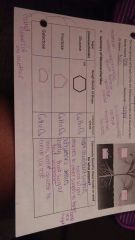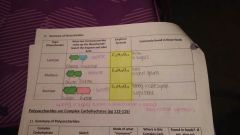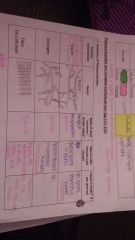![]()
![]()
![]()
Use LEFT and RIGHT arrow keys to navigate between flashcards;
Use UP and DOWN arrow keys to flip the card;
H to show hint;
A reads text to speech;
44 Cards in this Set
- Front
- Back
- 3rd side (hint)
|
What does Carbohydrates mean? |
Hydrated Carbon |
|
|
|
What elements do carbohydrates contain? |
Carbon Hydrogen Oxygen |
CHO |
|
|
Carbs come mainly from what? |
Plant foods such as fruit, vegetables and grains |
|
|
|
Plants make the most abundant carbs called what? |
Glucose |
|
|
|
Where does the energy contained in a carbohydrate originally come from? |
The sun, which is through the process of Photosynthesis in plants |
|
|
|
Carbs can be classified as what? |
Simple or Complex |
|
|
|
Simple carbs are called..? |
Sugars |
|
|
|
The two groups of simple carbs are called...? |
Monosaccharides = Mono means 1 and Saccharide means sugar And Disaccharides= Di means 2 |
|
|
|
Summary of Monosaccharides |
Glucose = C6H12O6 commonly found in: Blood sugar And attaches itself to other sugars to form complex sugars
Fructose= C6H12O6 commonly found in: Fruit sugar Fruits and Vegetables
Galactose= C6H12O6 commonly found in:
Nothing but joins with glucose to create Lactose
****called insomers of one another
|

|
|
|
Summary of Disaccharides |
Lactose= Glucose and Galactose make it up = C12H22O11 commonly found in: Milk Dairy products
Maltose= Glucose and Glucose make it up= C12H22O11 commonly found in: Malt Grains
Sucrose= Glucose and Fructose make it up= C12H22O11 commonly found in: Honey Maple syrup Sugarcane
*** Linking 2 sugars to form a disaccharide is called dehydration synthesis |

|
|
|
Summary of Polysaccharides |
Starch (our cells cannot use complex starch molecules as they exist in plants)= it is made with glucose= it is stored in plants= it is found in foods such as grains, legumes, and potatoes
Glycogen= it is made with glucose= this is stored in the liver and muscles= it is not stored in food
Fiber= it is made with glucose= forms the support structures of leaves, stems and plants= is commonly found in grains, rice, seeds, legumes and fruits it is made with glucose= forms the support structures of leaves, stems and plants= is commonly found in grains, rice, seeds, legumes and fruits is made with glucose= forms the support structures of leaves, stems and plants= is commonly found in grains, rice, seeds, legumes and fruits is made with glucose= forms the support structures of leaves, stems and plants= is commonly found in grains, rice, seeds, legumes and fruits is made with glucose= forms the support structures of leaves, stems and plants= is commonly found in grains, rice, seeds, legumes and fruits stems and plants= is commonly found in grains, rice, seeds, legumes and fruits stems and plants= is commonly found in grains, rice, seeds, legumes and fruits stems and plants= is commonly found in grains, rice, seeds, legumes and fruits
|

|
|
|
What is Insoluble fiber? |
Insoluble fiber are those that do not typically dissolve in water Also promotes regular bowel movements, alleviate constipation and reduce the risk of Diverticulosis Examples are: Wheat, grains, and many vegetable |
|
|
|
What is Soluble fiber? |
Soluble fibers are those that dissolve in water Easily digested by bacteria, promotes softer bowel movements, and reduces the risk of heart disease and type 2 diabetes. Examples: Citrus fruits, berries, oat products and beans |
|
|
|
Carbs are an excellent source of what? |
Energy, it provides 4 kcals or energy per gram |
|
|
|
Although our bodies can use proteins and fat for energy, what depends almost exclusively on glucose? |
Red Blood Cells Brain and Nervous Tissues |
|
|
|
What is Carbs Fuel Daily? |
Carbs Fuel Daily Activity is when the body relies mainly on carbs and fat for energy for daily activities |
|
|
|
What is Carbs Fuel Exercise? |
Carbs Fuel Exercise is when the exercise intensity increases, and the body starts to use more carbs than fat |
|
|
|
During light exercise, energy comes from what % of carbs and what % of fat? |
12.5% Carbs 87.5% Fat |
|
|
|
During moderate exercise, energy comes from what % of carbs and what % of fat? |
45% Carbs 55% Fat |
|
|
|
During intense exercise, energy come from what % of carbs and what % of fat? |
67% Carbs 33% Fat |
|
|
|
What is Ketosis? |
Ketosis is when we do not eat enough carbs, and our bodies seek for another alternative source of fuel for our brain, and begins to break down stored fat |
|
|
|
What is Ketoacidosis? |
Ketoacidosis is when the ketones level is too high causing the blood to become acidic, this can cause a coma leading into death |
|
|
|
What is Gluconeogenesis? |
Gluco: glucose Neo: New Genesis: To create "Creating New Glucose" from protein and muscle Gluconeogenesis is when the body turns to proteins in the blood and tissues into amino acids, then converting them to glucose, this dangerous because your body is literally "eating itself" Gluconeogenesis is a CATABOLIC process |
|
|
|
List 6 benefits of including fiber in our diet |
May lower the risk of colon cancer Promotes bowel health by preventing hemorrhoids, constipation etc May lower the risk of heart disease May enhance weight loss May lower the risk of type 2 diabetes |
|
|
|
When carbs are eaten, the glucose, fructose and galactose travel to the... |
Liver |
|
|
|
If glucose is needed for immediate energy, where is it released to? |
To the bloodstream |
|
|
|
If glucose is not needed immediately for energy, it will be stored as what and in which organs? |
It will be stored as glycogen in the liver and muscles |
|
|
|
This stored glycogen can be converted back into glucose to.. |
Supply the body's energy needs |
|
|
|
Between meals, the liver is working doing what? |
Converting between glucose and glycogen to maintain proper levels of glucose in the blood |
|
|
|
When we eat a meal, our blood glucose level rises.. Why can't glucose alone in the blood help nerves, muscles and other organs? |
Because the glucose molecules are too large to cross cell membranes independently |
|
|
|
Glucose needs assistance from what hormone? |
Insulin |
|
|
|
What organ releases this hormone? |
The Pancreas |
|
|
|
What are the two jobs for insulin? |
Insulin increases blood levels of glucose if low, helps transport glucose from blood into cells Insulin also stimulates the liver and muscles to take up glucose and store it as glycogen |
|
|
|
When you haven't eaten in sometime, blood glucose level declines... The pancreas releases a different hormone called... |
Glucagon |
|
|
|
What are the two jobs of glucagon? |
Stimulates breakdown of glycogen in the liver into glucose for energy Assists in the breakdown of body proteins to amino acids, so that the liver can stimulate gluconeogenesis, the production of new glucose from amino acids |
|
|
|
What is Hypoglycemia? |
Hypoglycemia is when blood glucose falls to lower than normal levels You start to feel shaky and hungry |
|
|
|
When can it happen? |
If someone's pancreas secretes too much insulin after a high-carb meal Blood clears glucose out of the body too quickly Diabetics who are not treated properly |
|
|
|
What is Glycemic Index? |
Glycemic index is the foods with a high GI which trigger insulin release and cause blood levels to rise |
|
|
|
Foods with high Glycemic index trigger the hormone insulin causing the blood levels to.. |
Drop |
|
|
|
Which carbohydrate has the highest GI and which carbohydrate has the lowest? |
Highest GI: white rice Lowest GI: an apple |
|
|
|
The current RDA (Recommended Daily Allowance) suggests that adults 19 years and older take in at least how many grams per day? |
130 grams per day |
|
|
|
AMDR (Acceptable Macronutrient Distribution Range) for carbs is what to what % of total energy intake? |
45 to 65% Focus on foods high in fiber and low in added sugars |
|
|
|
What does it mean when it says "Americans Eat Too Much Sugar"? |
Sugars are added to foods during processing or preparation (soft drinks, cookies, candy, fruit drinks) Unexpected sources include, peanut butter, flavored rice mixes, canned soups |
|
|
|
Why do sugars have a bad rap? |
Dental problems and tooth decay Associated with increased levels of diabetes and obesity Unhealthy levels of Blood Lipids |
|

